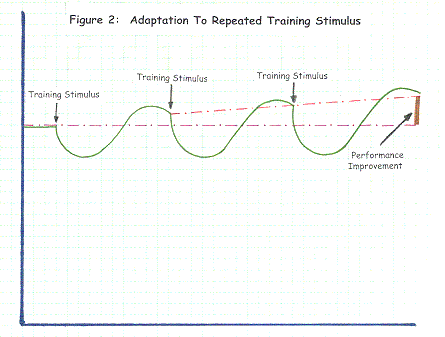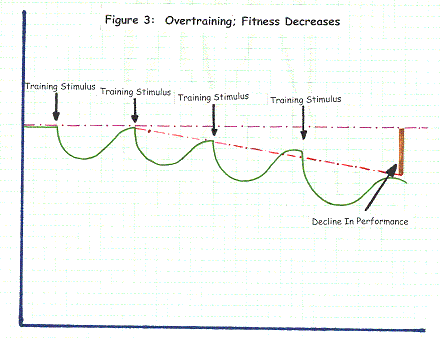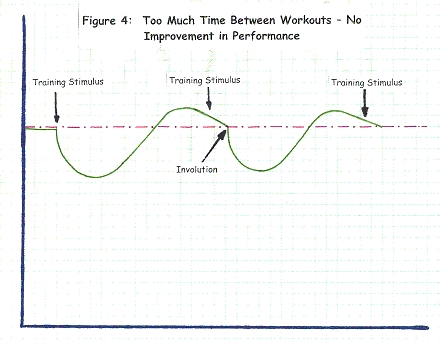When you come to boot camp, your body goes through a cycle. At the beginning of the workout, you should feel strong & fresh. As the workout progresses, however, you will become increasingly fatigued. This is known as overloading the body, and it is a requirement for athletic development. You need to push your body just past your current fitness level in order to stimulate fitness gains. Once you have completed the class, recovery begins. During the recovery process your body restores depleted energy reserves and repairs structures and tissues that were damaged during the workout. Beyond mere restoration, however, lies the concept of supercompensation whereby the body brings your fitness to a level above where it was before the workout. Over time, this supercompensation is displayed through increased endurance, power and speed.
The general workout/recovery cycle looks like this:

As you can see, the curve representing your fitness level starts out across the horizontal line. As your workout progresses,your fitness actually decreases, given that your capacity to handle work decreases as you become fatigued. The lowest point of the curve represents the greatest level of fatigue you experience, and corresponds to the end of the workout. As soon as you stop working out, the recovery process begins. Recovery continues until the body is completely refreshed and restored, then actually continues just a bit longer in order to increase your fitness just a little bit. Over time, the total of these workout/recovery cycles is known as the “training effect”, and the increase in fitness is represented below by the upward-sloping dotted line in the diagram below.

At its most basic level, therefore, increases in fitness are the result of repeated workout/recovery cycles: Said another way:
Workout fatigue + recovery = training effect
Effectively managing this cycle, therefore, is of primary importance to you! If you balance your training load with recovery abilities correctly, your workout/recovery chart would look something like Figure 2. If your workout/recovery plan is out of balance, however, one of two things can happen. The workout/recovery mismatch occurs when inadequate recovery time is taken following each workout. You will begin your workout without recovering fully, as shown below:

As you can see from the above diagram, another training stimulus is applied to the person before they are fully recovered. This leads to increased fatigue, and being set up for injury. Over time, if someone does not incorporate additional recovery into their schedule, their fitness will actually DECLINE. (as depicted by the downward-sloping dotted line
On the other hand, if you engage in training bouts too infrequently, you will experience involution – a decrease in fitness from disuse:

As you can see from the above diagram, once you’ve completed a single workout/recovery cycle, you experience supercompensation. If you do not engage in another training bout shortly after supercompensation occurs, however, you will experience involution, or a decrease in your fitness level. Involution begins within a matter of a few days, but thankfully even a minimal amount of activity can prevent involution. Involution also introduces the concept of detraining, or a decrease in fitness level. However, if you have been training steadily for a year, it is going to take longer to lose all your fitness than if you’ve only been training for a month. Second, the higher your fitness level is, the faster your fitness drops. Said another way, if you are in absolute peak form, you can lose 5-8% of your fitness after just one week of complete inactivity. Again, a minimal amount of activity can maintain your fitness, and high-intensity activity helps maintain fitness the best.
We hope this helps you stay motivated as you work towards your fitness goals, while keeping your body working FOR YOU in the long run and injury-free.. In short- LESS can be MORE in training as long as when you are working out you are pushing yourself with high-intensity activity like our Boot Camp classes.
Feel free to reach out with questions on this subject!
